Hello everyone and welcome back to another blog post. Our most recent project has been quite an exciting one. The past project was about the wrongdoings of the Canadian government and about the apologies that were made. We learned a lot about what makes a good apology and what makes a bad one. We also learned a lot about ethical judgment. Our final product would be on display in the Winter Exhibition of 2022. Throughout this post, I will be taking you through our project and the Winter Exhibition.
DQ: How can we keep apologies for past wrongdoings alive so they are remembered – and not repeated – today?
Answer: We can keep apologies for past wrongdoings in various ways. For example, you could make a monument to go in a designated space that was relevant to the event. You could try and change the school curriculum to keep younger generations in the know about what happened. These are just some ways that you could keep past wrongdoings alive.
In this project, we learned a lot about ethical judgment. We had to understand that ethical judgment could be positive or negative. It could be stated or implied. Ethical judgment should consider the interests and perspectives of everyone that was involved. It should be sensitive to historical context. We also did an activity that shed some light on what ethical judgment is. In class, we read 3 statements and we had to determine which had facts and which had judgments. We had to keep in mind everything that we had learned so far about ethical judgment. Below you can read the three statements that we had to access.
1. Muslim terrorists killed 3000 innocent people when they bombed the World Trade Center in New York City.
2. Thirty freedom fighters from Saudi Arabia crashed a plane into a building in New York City as a protest against the unlawful actions carried out in the Middle East by imperialist Western regimes.
3. Three thousand people died when thirty men from Saudi Arabia crashed a plane into a building in New York City.
In the end, we decided that the 3rd statement was fact and had no judgments in it. This would be a massive part later on in the project because we would be recording a voice note that would be played at the Winter Exhibition. It would be talking about the event that we would eventually choose and we could be using our ethical judgment to determine if the actions of the Canadian government were just or unjust.
To solidify our understanding of ethical judgement, we had to write a paragraph on the Ukrainian Internment during WWI. Below you can read the paragraph that I crafted after learning about ethical judgment.

Next, we picked the topic that our overall end product would be based around. I picked the Canadian government’s actions against the Japanese Canadians during WWII. We then gathered tons of information and organized it in a chart that we would come back to many times throughout the project. This is where we had to do a chunk of our information collection. We went back a revised this many times and it is where we did a lot of self-directed learning. You can check out my completed chart below ⬇️
Doing this chart would help to make the Keynote which would be on display next to our memorial at the Winter Exhibition. We learned how to annotate and make summaries of primary sources. You can check out my Keynote below ⬇️
As I mentioned above, we wrote and recorded voice notes that would be on display at the Winter Exhibition. Using the information that we had already gathered and organized from the previous keystones, it was pretty easy to come up with a quick blurb about our opinion on the ethical judgement of our topic. I think this was a really important step in this project because it finalized our understanding and it gave us one last time to take a good think about our topic. Below you can hear my audio clip ⬇️
Next, we had to learn about symbolism and theme. We studied what made memorials impactful versus what made memorials ineffectual. For the Winter Exhibition, the theme of it was the new movie Avatar. So we had to connect our final product to the avatar theme. The group that we were originally in was property rights because we were going to be talking about how the Japanese Canadians had their personal belongings taken away from them, but in the end, we were in exploited resources. Well it was tricky to connect Japanese internment to Avatar initially, I think that all of the great learning that we did about theme and symbolism helped us be able to make that connection in a stronger way than we would’ve before.
And finally, our final product was approaching needing to be done. To start with the process of making our memorial which would go in the winter exhibition, we had to prepare. Below you can see the chart that we made with our thoughts and ideas and kind of all of the brainstorming that we did in class. We made a list of things that we would need for each of the supposed scenes that we were going to have on the next day we brought it in and started creating. We probably spent about 10 hours working on our final product and there was blood sweat and tears, literally all of those. We used various methods to create our final product. We wanted to make sure that every single piece of our monument was very representative of Japanese culture. So, in the end, that’s why we decided to do origami for the majority of the action pieces. We used paper Mâché and lots of cardboard. Scissors and glue and in the end we made a truck. It represented Canada. In the bed of the truck was a scene of the Japanese Canadian’s homes and impounded boats and personal belongings that were all being taken away from them in the bed of the said truck. Below you can see some pictures of us making it and our final product at the winter exhibition along with the room that we helped create ⬇️
The school exhibition of learning was a resounding success, with students, teachers, and parents all impressed by the high quality of the projects on display. The exhibition provided an opportunity for students to showcase their knowledge and understanding of a wide range of subjects, and it was clear that a great deal of effort had gone into the preparation of every project. The exhibition was a celebration of learning, and it served to strengthen students’ understanding of the subjects they had studied. It also provided a sense of pride in the hard work and effort that had gone into the final product. Overall, the school exhibition of learning was a valuable and enriching experience for all those who participated.






















